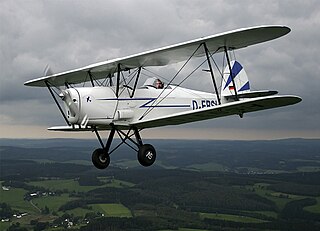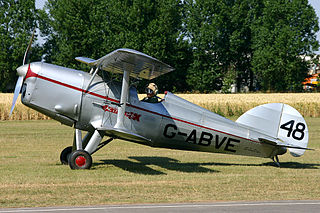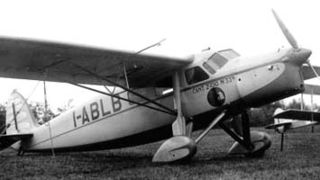
The DH.83 Fox Moth was a successful small biplane passenger aircraft from the 1930s powered by a single de Havilland Gipsy Major I inline inverted engine, manufactured by the de Havilland Aircraft Company.

The Stampe et Vertongen SV.4 is a Belgian two-seat trainer/tourer biplane designed and built by Stampe et Vertongen. The aircraft was also built under licence in France and French Algeria.

The Arrow Active is a British aerobatic aircraft built in the 1930s.

The de Havilland DH.81 Swallow Moth was aimed at the low-cost sporting aircraft market during the Great Depression. It was a single-engined two-seat low-wing monoplane; only one was built.
The Lemberger LD20b was a single-engine cantilever biplane designed to be easily towable behind a car. Built in Germany in 1971, it made several flights but did not enter production.

The IAR-22 was a single engine basic trainer built in Romania in about 1934. It was a low-wing monoplane with two seats in tandem and a fixed conventional undercarriage.

The Hispano-Suiza E-34, later renamed Hispano HS-34, was a Spanish single engine, tandem seat biplane, designed as a basic trainer. Twenty five were ordered by the Aeronáutica Naval, but only five had been completed when the Spanish Civil War intervened.

The CANT Z.1010 was a single engine, five seat Italian passenger aircraft flown in the mid-1930s. Only one was built.

The Pander E was the first indigenous Dutch training aircraft, used by clubs and also privately owned. A two-seat, single-engine biplane, 17 were built in the Netherlands from 1926 with engines of increasing power.

The Pander P-1 and P-2 were close to-identical single engine Dutch sports aircraft with tandem seats and a parasol wing, first flying in 1929. Only two were built.
The Pander P-3 was a parasol wing, two seat, single engine sports aircraft designed in the Netherlands in the early 1930s. Only one was built.

The Koolhoven F.K.47 was a 1930s one-off two seat biplane designed and built in the Netherlands for an individual customer as a sport and touring aircraft.
The Koolhoven F.K.45 was an aerobatic biplane built to the requirements of one pilot who flew it at airshows in the mid-1930s. Only one was built.

The Koolhoven F.K.54 was a Dutch single-engine, three-seat touring aircraft with a retractable undercarriage. It flew shortly before the start of World War II and its development was abandoned after its first flight as attention turned to military aircraft.
The Lambach HL.1 was a one-off, simple tandem two seat trainer designed and built by members and ex-members of the Delft Student Aeroclub (DSA) in the Netherlands in the mid-1930s.
The Bloch MB.90 was the first all-metal French light aircraft. Only two aircraft were completed, making their first flights in 1932, though there were several variants.

The Morane-Saulnier MS.350 was a French aerobatic trainer flown in 1936. Only one was built but it had a long career, flying post-war until the 1960s.
The Curtiss-Reid Courier was designed in Canada in 1931 as a specialist, non-passenger carrying, mailplane capable of maintaining services in Canada's hard winters. The 1930s depression led to the end of government subsidised airmail contracts and only one prototype flew. It was lost in 1933 during preparations for a private, long distance flight.

The Raab-Katzenstein KL.1 Schwalbe (Swallow) was a German two-seat biplane produced in the 1920s. About fifty were built and the type became well known as an aerobatic aircraft, performing at many displays in the hands of pilots like Gerhard Fieseler.

The Day A Special, named Errant, was designed in the U.S. by Charles Healey Day, as a safe, easy to fly tourer, for two sitting side-by-side. In 1931 the designer and his wife flew Errant on a seven month world tour.














